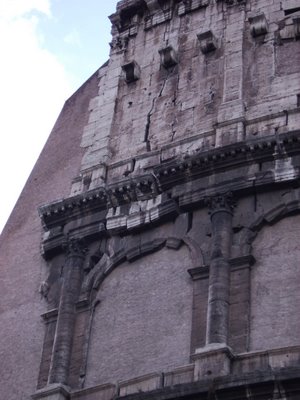025 colosseo in 4 foto

2. Brick wall introduced (unknown date), presumably
to stabilize the end condition of the wall and prevent collapse.
This type of intervention is not en vogue among preservationists
and conservationists today. Pros: structural stability,
life safety, easy to distinguish that this is not original,
clearly marked with date of intervention on placards.
Cons: does not retain monument in original form,
is not a reversible intervention, does not adhere to
"minimal intervention" policy and is a severe change
to substructure and foundation system. (The foundation of
the Colosseum consists of at least one more layer of arched
walls subgrade.)

3. End bay - this arch is obviously collapsing. Without the
intervention of the brick wall as backup, this portion of
the wall would surely have collapsed.

4. Close up view of the cracking and displacement
of the masonry. I don't know how the stones have been
attached to the newer brick wall. One of the important
precepts of preservation/conservation is to use compatible
materials in both chemical compatibility and mechanical
(displacement) compatibility. (If I have some time, I could
get the answer in the library here of course!)



2 Comments:
"This type of intervention is not en vogue among preservationists
and conservationists today."
When did this modern type of preservation come into vogue? Is it more "en vogue" primarily in the USA? or is it a Western philosophy?
Good question.
I am definitely not an expert on the recent history of preservation/ conservation trends in the US or around the world.
I do know that there is more and more emphasis on being ultra-sensitive to the historic fabric of the built heritage. This is a quasi-religious reverence to materials - bricks, mortar, wood, etc. It's also important to practice minimum intervention - only when absolutely necessary, because what ever you do to the environment becomes part of the history and has to be maintained. For that reason, there is importance assigned to the reversibility of the said intervention, so if in 100 years people decide it's inappropriate, they can reverse it.
As far as the US vs. the rest of the world - let's just say that the US is less concerned about the built heritage than Europe. So the rules are considerably more lax. And I'm still learning about trends in S. America, Africa, Middle East, Asia, Australia, so I can't comment on that as yet.
Posta un commento
<< Home